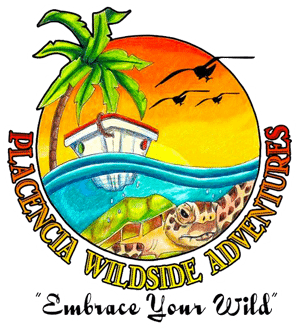|
Coatis, also known as coatimundis (/koʊˌɑːtɪˈmʌndi/), are members of the faccoon family. There are four (4) species of coati's in native to North, Central & South America. Depending on the species, coati's can be found in the tropical rainforests, dense forests, mountains, grasslands or deserts. They are diurnal mammals native to South America, Central America, Mexico, and the southwestern United States. The name coatimundi purportedly derives from the Tupian languages of Brazil. The coati is also known in English as the hog-nosed coon. Physical characteristics Adult coati's measure 13 to 27 inches from head to the base of the tail, which can be as long as their bodies. Coati's are about 12 inches tall at the shoulder and weigh between 4.4 & 17.6 pounds, about the size of a large house cat. Males can become almost twice as large as females and have large, sharp canine teeth. The above measurements are for the white-nosed and South America coati's. The two mountain coati's are smaller. All coati's share a slender head with an elongated, flexible, slightly upward-turned nose, small ears, dark feet, and a long, non-prehensile tail used for balance and signaling. Ring-tailed coati's have either a light brown or black coat, with a lighter under-part and a white-ringed tail in most cases. Coati's have a long brown tail with rings on it which are anywhere from starkly defined like a raccoon's to very faint. Like raccoons and unlike ring-tailed cats and cacomistles, the rings go completely around the tail. Coati's often hold the tail erect; it is used as such to keep troops of coati's together in tall vegetation. The tip of the tail can be moved slightly on its own, as is the case with cats, but it is not prehensile as is that of the kinkajou, another procyonid. Coati's have bear- and raccoon-like paws, and walk plantigrade (on the soles of the feet, as do humans), like raccoons and bears. Coati's have non-retractable claws. Coati's also are, in common with raccoons and other procyonids (and others in the order Carnivora and rare cases amongst other mammals), able to rotate their ankles beyond 180°; they are therefore able to descend trees head first. Other animals living in forests have acquired some or all of these properties through convergent evolution, including members of the mongoose, civet, weasel, cat, and bear families. The coati snout is long and somewhat pig-like, part of the reason for its nickname 'the hog-nosed raccoon'. It is also extremely flexible – it can be rotated up to 60° in any direction. They use their noses to push objects and rub parts of their body. The facial markings include white markings around the eyes and on the ears and snout. Coati's have strong limbs to climb and dig and have a reputation for intelligence, like their fellow procyonid, the raccoon. They prefer to sleep or rest in elevated places and niches, like the rainforest canopy, in crudely built sleeping nests. Coati's are active day and night. Behavior Little is known about the behavior of the mountain coati's. Unlike most members of the raccoon family, coati's are primarily diurnal. Coati females and young males up to two years of age are gregarious and travel through their territories in noisy, loosely organized bands made up of four (4) to thirty (30) individuals, foraging with their offspring on the ground or in the forest canopy. Males over two years become solitary due to behavioral disposition (collective aggression) from the females and will join the female groups only during the breeding season. When provoked, or for defense, coati's can be fierce fighters; their strong jaws, sharp canine teeth, and fast scratching paws, along with a tough hide sturdily attached to the underlying muscles, make it very difficult for potential predators (e.g., dogs or jaguars) to seize the smaller mammal. Coati's communicate their intentions (or moods), with a chirping, snorting, or grunting sound. Different chirping sounds are used to express joy during social grooming, appeasement after fights, or to convey irritation or anger. Snorting while digging, along with an erect tail, states territorial or food claims during foraging. Coatis additionally use special postures or moves to convey simple messages; for example, hiding the nose between the front paws as a sign for submission; lowering the head, baring teeth, and jumping at an enemy signal an aggressive disposition. Individuals recognize other coati's by their looks, voices, and smells, the individual smell is intensified by special musk-glands on their necks and bellies. Coati's from Panama are known to rub their own fur and that of other troop members with resin from Trattinnickia aspera (Burseraceae) trees, but its purpose is unclear. Some proposed possibilities are it serves as an insect repellent, a fungicide, or as a form of scent-marking. Fun Facts
Diet & Feeding Coatimundi's are diurnal, which means they like to eat during the day. Coatimundi's are all about snacking. It uses its long, flexible nose to probe gaps between rocks and search under piles of leaves for grub. Coatis eat insects, fruit, rodents, lizards, and small snakes.Coatimundi's are omnivores; which means their diets consist of mainly leafy vegetation, ground litter, invetebrates (such as trantulas) and fruit. They also eat small vertebrate prey, such as lizards, rodents, small birds, birds' eggs, and crocodile eggs. Their long snout (has an acute sense of smell), assists the paws in a hog-like manner to unearth invertebrates. Reproduction The Coatimundi mating season, typically corresponds with the start of the rainy season, when good is most abundant. Especially fruits: between January and March in some areas, and between October and February in others. Females (along with juveniles) band together in groups of about 30, at the beginning of the breeding season, they will accept an adult male into their band. This leads to a polygynous mating system. At age two, males will leave and live on their own. The pregnant females separate from the group, build a nest on a tree or in a rocky niche and, after a gestation period of about 11 weeks, give birth to litters of three to seven kits. About six weeks after birth, the females and their young will rejoin the band. Females become sexually mature at two years of age, while males will acquire sexual maturity at three years of age. Ecology and Conservation The coatimundi is locally threatened in some areas as a result of ongoing habitat loss and hunting. The Coatimundi has a wide distribution range and is present in many protected areas across its range. Coati's are classified as an endangered species in New Mexico and it given total legal protection there. However in Arizona, where the largest population lives, they are subject to year round hunting. Coatis are an important food source for larger predators, and in some regions, and are hunted for their meat by humans. Coati predators include jaguarundis, anacondas, maned wolves, boa constrictors, foxes, dogs, tayras, ocelots, and jaguars. Large raptors, such as ornate hawk-eagles, black-and-chestnut eagles, and harpy eagles, also are known to hunt them. White-headed capuchin monkeys hunt their pups. These animals help control insect, reptile, and amphibian populations as well. However, they are also seen (by some), as agricultural pests, damaging farmers' crops. In Captivity Coati's are one of five groups of procyonids commonly kept as pets in various parts of North, Central and South America, the others being the raccoons (common and crab-eating), the kinkajou, the ring-tailed cat and cacomistle. However, while both the white-nosed and South America coati's are common in captivity, mountain coatis are extremely rare in captivity. Coatis are small creatures that can be wild, somewhat difficult to control or train in some cases, and generally behave in a manner radically different from that of a pet dog. Optimally, they should have a spacious outdoor enclosure and a coati-proofed room in the house and/or other climate-controlled place, as well. They can be given the run of the house but need careful watching, more careful in some cases than others. It is possible to litter or toilet train coati's; if one cannot be trained as such, it is still possible to lessen problems in that they tend to designate a latrine area, which can have a litter pan placed in it as is done with many ferrets, pet skunks, rabbits, and rodents. Coati's generally need both dog and cat vaccines for distemper and many other diseases and a killed rabies vaccine. They can be spayed or neutered for the same reason as cats and dogs and other pets. The Belize Zoo Coatimundi(Nasua narica)The Coatimundi, also known as the White-nosed Coati, is diurnal, living both on the ground andin the trees. This member of the racoon family is omnivorous, feeding on fruits, invertebrates,and other small animals. They feed by using their long noses, poking them under rocks and intocrevices, and using their long claws to dig holes or tear apart rotting logs.The coati often is seen in large groups of up to 30 individuals. When surprised, the entire groupwill leap into the trees while emitting clicking and explosive "woofs" type of sounds. During thenight, coatis sleep in the tree tops in nest of leaves and branches.Coatimundis are found throughout Belize, from the mangrove forests of the coasts, thesavannas of the lowlands, the dense tropical forest of the interior. They range all throughCentral America and are quite common in Belize. Locally in Belize, the coati is known as"quash".
0 Comments
Your comment will be posted after it is approved.
Leave a Reply. |
Is located on the island of Ambergris Caye, directly across from the Belize Barrier Reef, off the mainland coast of Belize. The property is nestled in a cluster of Australian Pine trees, backed to a littoral jungle, and surrounded by tropical gardens. It's about a one minute walk from the property to the beach, and a 10-15 minute drive from the island airstrip to the property.
We offer one bedroom suites (455 s.f.) of living area to include: livingroom, kitchenette, private bathroom and bedroom. We are also about a one minute walk from one of the best restaurants on the island serving (breakfast, lunch & dinner). Within walking distance you can find: (3) blocks is Robyn's BBQ (4) blocks is 2 fruit stands (5) blocks local grocery store IF YOU'RE COMING TO BELIZE TO............... If you're coming to Belize to dive the Blue Hole, descend the shelf walls at Turneffe, snorkel the Barrier Reef, explore Mayan ruins, rappel into a cave, kayak along the river through caves, zip line through jungle tree tops, hike through a cave to see an ancient human skeleton, swim with sharks, listen to Howler Monkey's, hold a boa constrictor, feed a jaguar, horseback ride through the jungle, canoe through a cave, rappel down a waterfall, sail around an island, enjoy cocktails & dinner to a sunset, climb 130' feet to the top of a Mayan ruin, rip up the jungle trails on an ATV, float through a series of caves on a tube, and sip on a rum punch..... then this is the place for you. Belize Budget Suites, offers you clean, affordable, attractive, accommodations, at prices that allow you to do all the things just mentioned. Archives
February 2021
Categories
All

For All Your Home Improvement Needs

For all Your Real Estate Needs
501-226-4400 10 Coconut Dr. San Pedro, Belize Your Ad Could Go Here
|















 RSS Feed
RSS Feed























